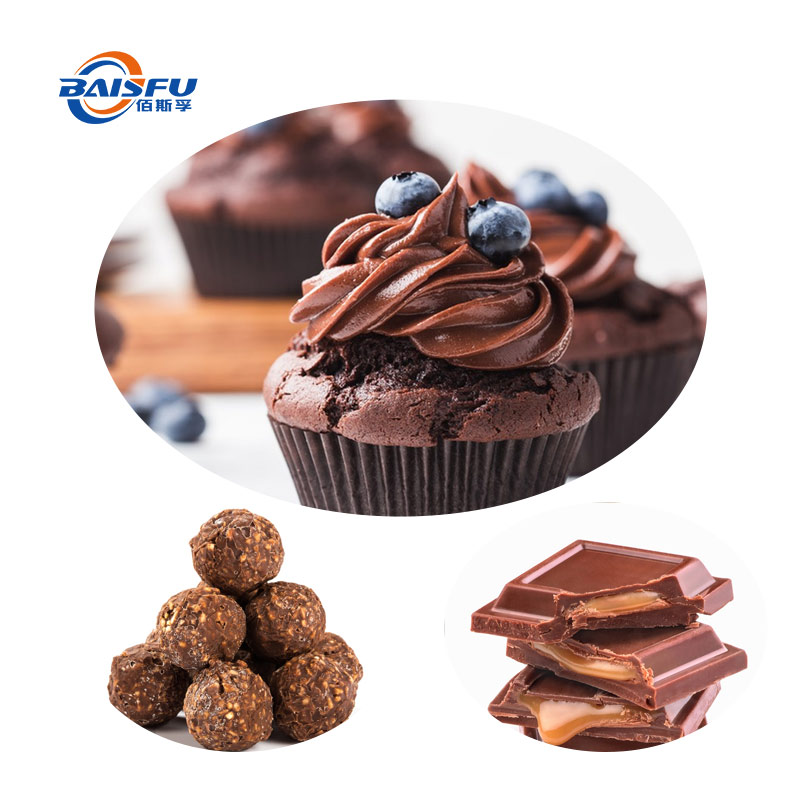Chocolate flavor: the "cocoa magician" on the tip of your tongue

1. Four core features of chocolate flavor
1. “Flavor fortress” under high temperature
Natural cocoa butter and aroma molecules are easy to volatilize and decompose during high-temperature processing (such as baking and sterilization), while chocolate flavors achieve “triple protection” through technology:
Microcapsule embedding: use maltodextrin and liposomes to encapsulate aroma molecules and withstand high temperatures above 180°C;
Maillard reaction enhancement: add reducing sugars and amino acids to generate caramel and baking aroma during baking;
Antioxidant stability: with vitamin E, BHA, etc., to extend the shelf life and retain flavor.
2. Precise reproduction and unlimited creation
Classic restoration: simulate the baking aroma of cocoa beans and reproduce the silky feeling of milk chocolate;
Cross-border breakthrough: mix anti-traditional flavors such as “white peach black chocolate” and “spicy smoked chocolate” to unlock taste imagination.
3. Low cost and high compatibility
The cost is only 1/5 of natural cocoa: 1kg chocolate flavor ≈ the aroma intensity of 50kg cocoa beans;
Adaptable to multiple matrices: water-soluble, oil-soluble and powdered flavors can be integrated into different forms of products such as ice cream, protein bars, and meal replacement shakes.
4. Health and environmental advantages
Low-sugar and low-fat formula: Use flavors to enhance the perception of “chocolate flavor” and reduce the actual addition of sugar and fat;
Sustainable substitution: Alleviate the problem of tropical rainforest deforestation caused by global cocoa cultivation (70% of the world’s cocoa is produced in ecologically fragile areas in West Africa).
2. Five major application areas of chocolate flavors
1. Baking and desserts: Save the “rollover scene”
Industrial baking: Add high-temperature resistant flavors to premixed powder to ensure the consistent flavor of mass-produced chocolate cakes;
Home desserts: Tempering-free chocolate flavors make DIY lava cakes and raw chocolate no longer rely on complex processes;
Health upgrade: Use flavors to make up for the lack of richness in cocoa powder in gluten-free and ketogenic baking.
2. Beverages: From “childhood memories” to “Internet celebrity hits”
Dairy products: Chocolate milk and yogurt use flavors to balance cost and taste to avoid cocoa powder precipitation;
Plant-based beverages: Oat chocolate milk uses flavors to cover up the beany smell while reducing the high calories brought by the addition of cocoa;
Alcoholic beverages: Baileys Irish Cream and Chocolate Stout rely on flavors to enhance the flavor level.
3. Snacks and candies: Low-cost “indulgence in silky smoothness”
Affordable chocolate: Cocoa butter substitutes use flavors to simulate natural cocoa flavors;
Cross-border snacks: Chocolate-flavored potato chips and nut coatings use flavors to achieve flavor attachment (no real chocolate wrapping is required);
Functional candies: High-protein energy bars use flavors to enhance “guilty satisfaction” and reduce consumers’ resistance to the astringency of high-protein powder.
4. Catering and fast-moving consumer goods: “secret weapons” in the B-end market
Coffee chains: Starbucks Mocha sauce and Luckin Chocolate Reina Ice rely on flavors to control costs;
Fast-food desserts: McDonald’s chocolate pie and KFC chocolate ice cream use flavors to achieve global standardized flavors.
5. Non-food sector: “Out-of-circle experiment” of sensory economy
Beauty and personal care: chocolate scented hand cream and shampoo create “sweet marketing”;
Home fragrance: candles and diffusers use chocolate essence to create a “warm and healing feeling”.

